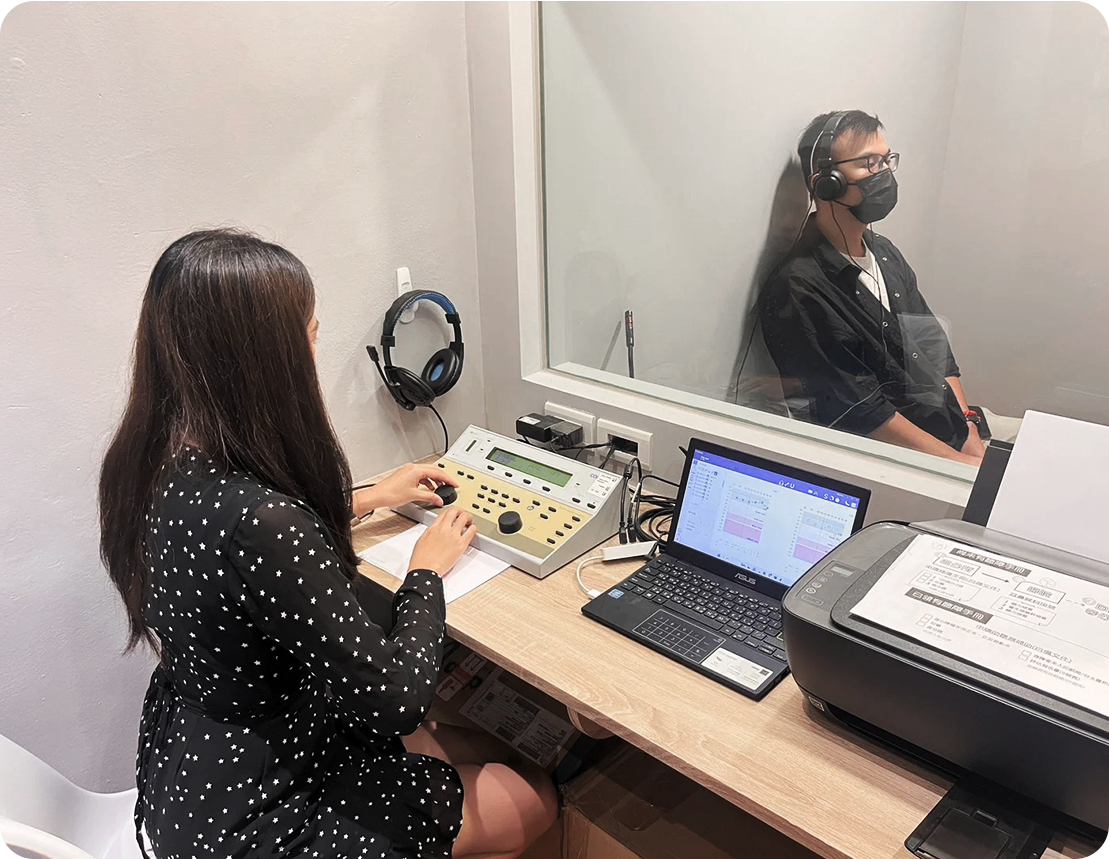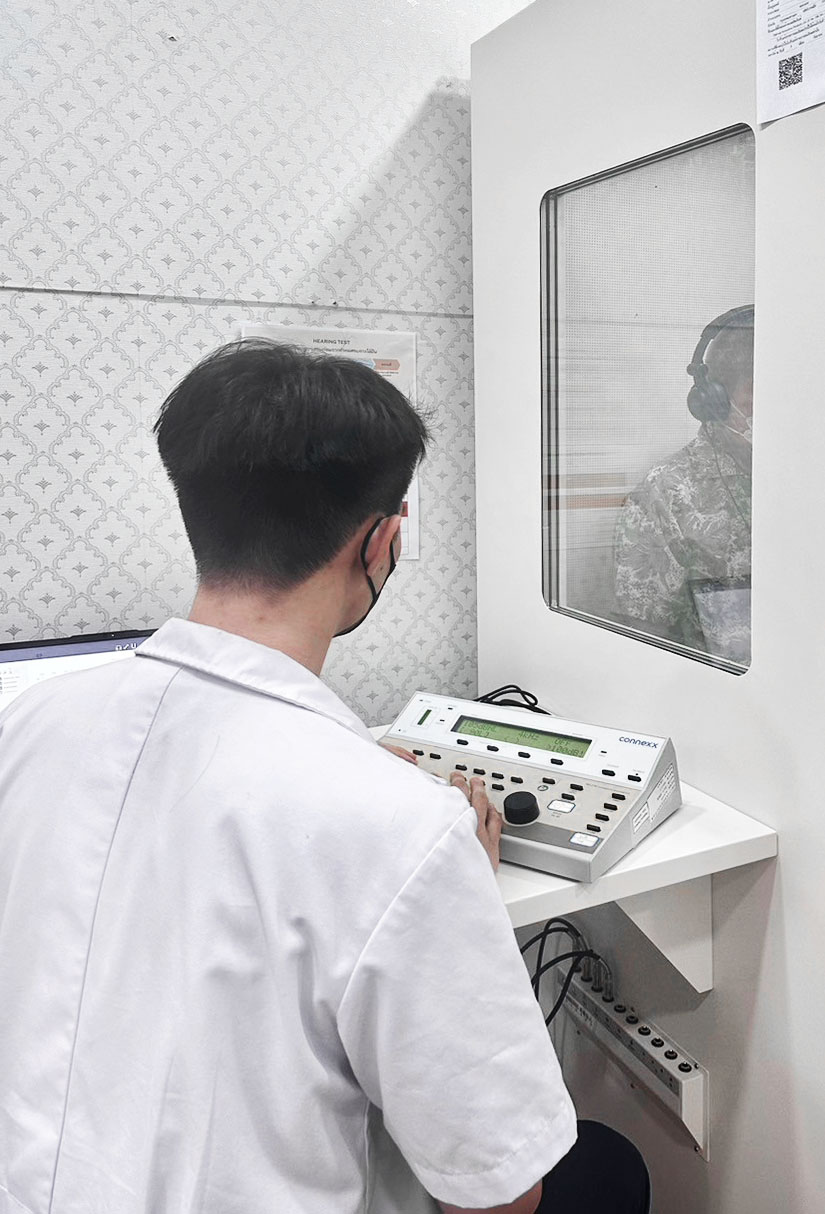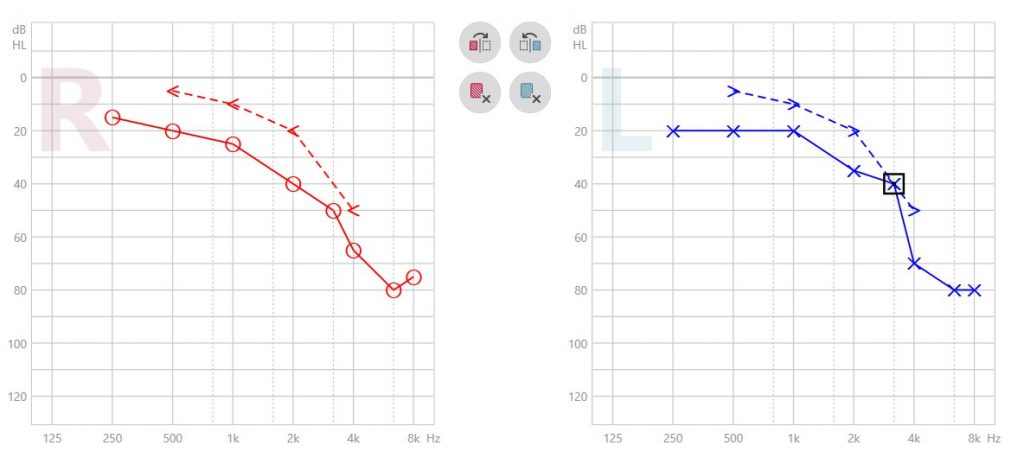A hearing test to get to know you better
Digibionic offers free hearing assessments using the PTA technique because we believe that hearing is an essential part of everyday life, enabling communication with others and helping prevent accidents. That’s why we are committed to providing modern technology and high-quality service to ensure everyone receives the most accurate hearing evaluation possible.
Our PTA hearing test is a simple yet precise method. This test uses professional audiometric equipment to deliver sounds at different frequencies and volumes to the ears, measuring response and hearing ability. It helps clients understand their hearing condition and determine whether any hearing difficulties are present.
The PTA hearing test at Digibionic is fast and accurate, typically taking only about 15 minutes. Conducted by experts, it ensures the most effective and reliable results.

What is a hearing test?

Hearing Test
It is an examination of the ear and auditory system to thoroughly evaluate hearing levels. This screening helps monitor and detect hearing loss. Individuals with normal hearing typically have hearing thresholds between -10 and 25 decibels. If the threshold is higher than 25 decibels, it is considered a hearing impairment.
The test measures hearing levels through two pathways: air conduction and bone conduction, conducted in a specially designed soundproof room.
When should we have a hearing test?
Before having a hearing test, you can observe some early signs that may indicate hearing difficulties, such as:
Frequently asking others to repeat themselves because speech sounds unclear
Trouble hearing conversations over the phone
Needing to turn up the TV or radio louder than usual
Speaking louder than before without realizing it
Experiencing frequent ear fullness or ringing in the ears (tinnitus)
Having a family history of hearing loss or deafness
Other symptoms may include decreased hearing ability, dizziness or vertigo, ear pain, ear discharge, difficulty understanding speech, or working in environments with constant loud noise. If you experience any of these symptoms, it is strongly recommended to have your hearing checked immediately.
How can we understand sound levels before choosing a hearing aid?

| Hearing level | Sound level dB | Hearing ability |
| normal | 0 – 25 | Can hear speech normally |
| Slightly deaf | 26 – 40 | I can’t hear soft voices. |
| Moderate hearing loss | 41 – 55 | Listen normally at a distance of 3-5 feet. |
| Very hard of hearing | 56 – 70 | Must speak loudly to be understood, cannot hear well |
| Severe hearing loss | 71 – 90 | You may hear shouting from a distance of 1 foot but not understand it. |
| deaf | 91+ and up | Can’t hear in noisy places |

When you receive a graph from a hearing test center, do you know how to read your hearing level from it?
For example, a hearing test graph includes:
Horizontal axis (frequency): Divided into six frequencies: low frequencies (250 Hz and 500 Hz), mid frequencies (1,000 Hz and 2,000 Hz), and high frequencies (4,000 Hz and 8,000 Hz). The frequencies most important for hearing, especially human speech, are 1,000 Hz to 4,000 Hz.
Vertical axis (sound level): Shows the hearing threshold in decibels. A level of 25 dB indicates normal hearing. If your test shows a threshold higher than 25 dB, it indicates hearing loss. You should see a doctor promptly and consider using a hearing aid to prevent further impact on your hearing ability.
“The red circles represent the hearing of the right ear,” and “the blue crosses indicate the hearing of the left ear.” If you experience significant hearing loss, it means there is a hearing impairment. You should have your hearing evaluated by a specialist to determine the extent of the loss and receive appropriate treatment.

Illustration showing hearing aid sound adjustment based on the hearing test graph (used together with the test results graph).
Digibionic offers free hearing assessments. If you have hearing difficulties, take care of your hearing as soon as possible—we are happy to assist you.
Who should have a hearing test?
Children
Although less common, hearing loss in children is increasing. Causes may include genetics, accidents, or exposure to dangerously loud environments. Children’s auditory systems are still developing and are highly vulnerable, especially in young children. Hearing impairments at this stage can lead to speech development issues, affecting learning and overall development.
Adults and Seniors
Hearing is essential for daily communication, and loss of hearing can lead to many problems. Adults and seniors have a higher risk of hearing loss, often unnoticed until it worsens over time. Causes include age-related degeneration, exposure to noise at home or work, and certain medications that damage auditory nerves. Untreated hearing loss may reduce brain activity and increase the risk of cognitive decline. Regular hearing assessments help prevent and reduce the severity of these issues.
Individuals with Hearing Difficulties
Anyone experiencing hearing loss, whether mild or severe, should have a hearing test immediately. Symptoms to watch for include decreased hearing, dizziness, ear pain, ear discharge, difficulty understanding speech, or working in consistently noisy environments. If you experience any of these, it is recommended to have your hearing checked as soon as possible.
Get a free hearing test today!
Get a free Discount Gift Voucher worth 990 THB
When you book a hearing test with us (limited availability)
Note: The hearing test is completely free of charge.
The discount can be applied to selected promotional items throughout its validity period.
Available upon visiting a Digibionic store for a hearing test.

เราใช้คุกกี้เพื่อพัฒนาประสิทธิภาพ และประสบการณ์ที่ดีในการใช้เว็บไซต์ของคุณ คุณสามารถศึกษารายละเอียดได้ที่ นโยบายความเป็นส่วนตัว และสามารถจัดการความเป็นส่วนตัวเองได้ของคุณได้เองโดยคลิกที่ ตั้งค่า